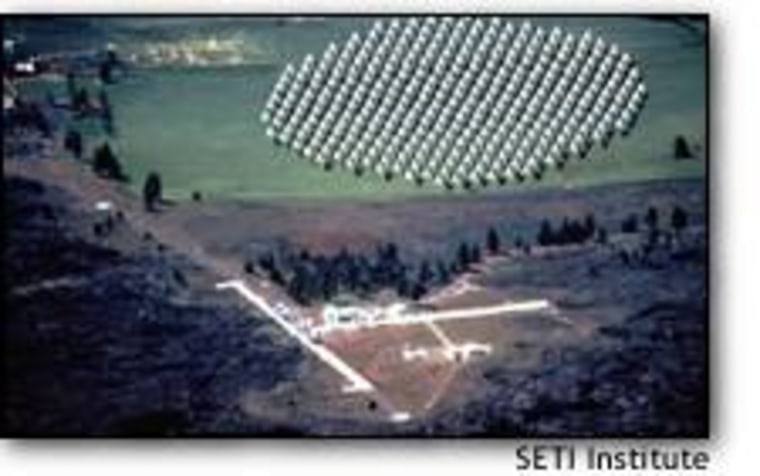Scientists searching for extraterrestrial intelligence are moving ahead with their plan to build a network of 500 to 1,000 satellite TV antennas — a virtual radio dish that could simultaneously listen for E.T. and observe the universe’s most distant objects.
OFFICIALS AT the SETI Institute formally announced the plan Monday, along with the University of California at Berkeley, which has endowed an academic position devoted to the search for extraterrestrial intelligence, known as SETI. The beginnings of the network would be built at the university’s Hat Creek Observatory near Mount Lassen in Northern California.
“The idea is to try to build a big telescope and do it inexpensively,” William “Jack” Welch, the first astronomer to hold Berkeley’s SETI position, said in a written statement.
“By using a large number of satellite TV antennas and inexpensive receivers we will build ourselves, we can get a very sensitive antenna that is much cheaper than the cost of building one big reflecting dish and one large receiver,” said Welch, who is the former director of Berkeley’s Radio Astronomy Laboratory.
“This represents a paradigm shift in the design and construction of radio telescopes,” said the SETI Institute’s Jill Tarter, who happens to be Welch’s wife. “We hope to demonstrate that a premium instrument need not have a premium price.”
The project, known as the 1-Hectare Telescope or 1HT, has been under discussion for months. The aim is to create an electronically linked network of 500 to 1,000 dishes with a diameter of 12 to 18 feet (4 to 6 meters). The total area would amount to one hectare — that is, 10,000 square meters or 2.47 acres.
Berkeley and the SETI Institute say the 1HT network could be completed by 2004 at a cost of $25 million. Such a facility would provide about as much observing power as the 300-foot Green Bank Telescope, now under construction in West Virginia, but at a third of the cost. In comparison, the world’s largest radio telescope at Arecibo in Puerto Rico has a collecting area of about 73,000 square meters.
Modern searches for extraterrestrial intelligence require such massive radio telescopes to look for signals from other solar systems, listening on certain frequencies. SETI scientists have often had to compete with other radio astronomers for precious time on facilities such as Arecibo.

The university said the Hat Creek prototype would incorporate a dozen small dishes. Hat Creek would probably serve as the site for the full 1HT network as well.
The network would allow for further expansion even beyond the 1-hectare mark. Indeed, the 1HT is viewed as merely a preliminary step toward a dish network 100 times bigger, dubbed the Square Kilometer Array.
ASTRONOMICAL MULTITASKING
Once completed, the 1HT would be the world’s largest observing facility devoted substantially to SETI research. The network would first search 1,000 nearby sunlike stars and eventually search 1 million candidate stars in the Milky Way galaxy, Welch said.
In an example of astronomical multitasking, the network could carry out other observations even as it listens for extraterrestrial signals.
“The instrument we want to build will have unique capabilities for observing objects from the solar system to the edge of the universe,” said Leo Blitz, director of Berkeley’s Radio Astronomy Laboratory. “Our goal is nothing short of standing the way radio astronomy has been done up to now on its head.”
The key to the network’s success would be the software and electronics used to blend the data from hundreds of separate dishes, experts said. In a December interview, Berkeley astronomer Dan Werthimer told MSNBC that “you still need a lot of computing power to synthesize all these dishes, but we think this problem is going to be solved over the next few years just because computers are going to get more powerful and cheaper.”
THEY ARE NOT ALONE
The 1HT project is by no means the only effort seeking to harness the power of distributed computing: In fact, the grass-roots SETI League has been pushing for five years to create a network of 5,000 amateur radio telescopes to conduct an all-sky search for microwave signals from extraterrestrial civilizations.
“We’re delighted that the SETI Institute is following our lead in recognizing the value of satellite TV dishes for credible SETI,” said H. Paul Shuch, executive director of the SETI League.
Shuch said the league was aiming to demonstrate a prototype of its Internet-linked dish network in July, during a conference at Green Bank. There would then be another year or two of testing, he said.
“The only purpose of the first-generation software is to find out what we did wrong so we can move ahead with the second-generation software,” Shuch joked.
Welch’s appointment to Berkeley’s SETI chair, meanwhile, found favor with Shuch and other SETI experts.
“This is something that absolutely delights me,” Shuch said. “I can think of nobody better qualified to head up this project than Jack.”
Frank Drake, president and one of the founders of the SETI Institute, told the Reuters news service that the endowed chair “confirms the legitimacy of SETI as hard-core science.”
Reuters contributed to this story.